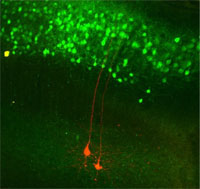Neurobiologists determine how the brain represents both faint and intense signals
November 6, 2009

Credit: Hillel Adesnik
The cerebral cortex, the outermost layer of the brain that plays a key role in attention, thought and consciousness, detects weak signals with remarkable sensitivity. Yet robust inputs don't swamp the system. It's like a speaker that can project both the faintest murmur and a torrent of sound, but how the brain manages to respond to such a wide dynamic range had puzzled neurobiologists.
Now biology professor Massimo Scanziani's group has figured out how one part of the brain readjusts its volume control. They found that the stronger the stimulus, the higher the current needed to fire a particular type of neuron called an L5 pyramidal cell, labeled red in the photo, which sends signals from the cortex to other parts of the brain.
Each L5 pyramidal cell receives signals from multiple neurons in other layers of the cortex, shown green in the photo. But the relative contribution of any one input drops as more neurons join in - like they do for a strong input - damping down the response enough to prevent an overload, the group reports in a forthcoming issue of Nature Neuroscience.
